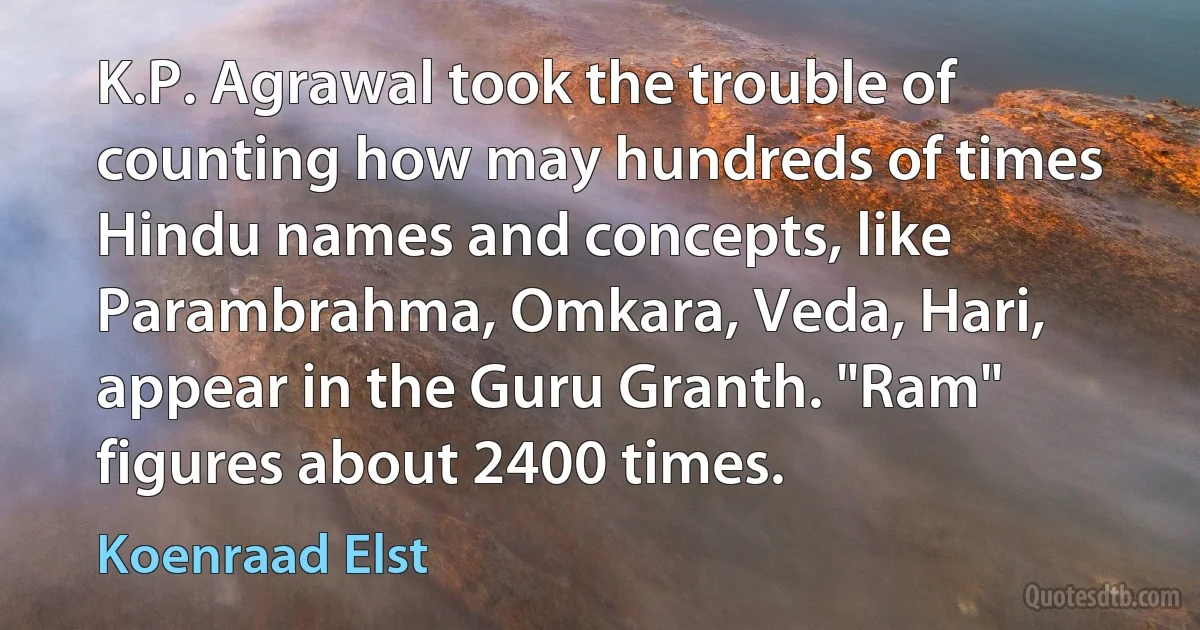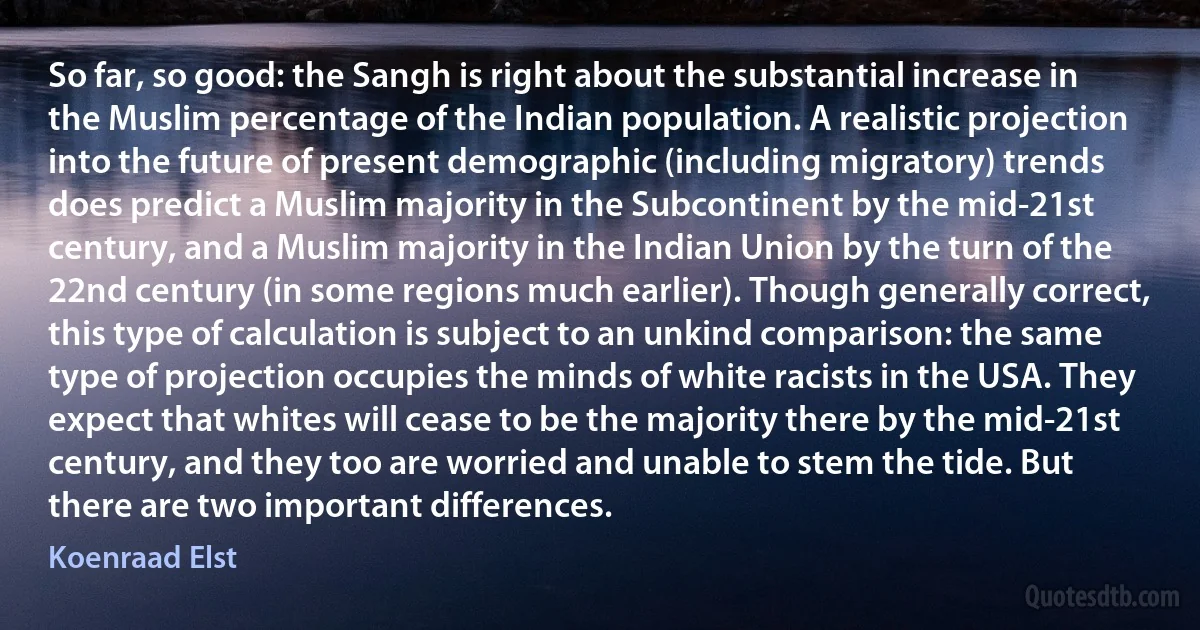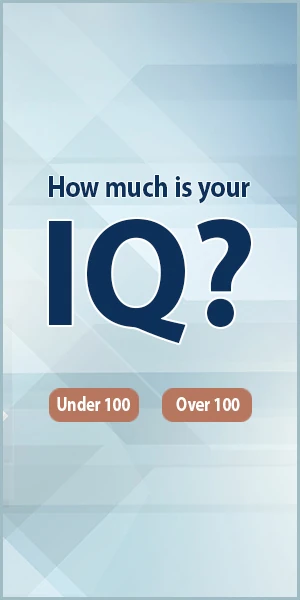Koenraad Elst quotes - page 7
India has its own full-fledged brand of negationism: a movement to deny the large-scale and long-term crimes against humanity committed by Islam. This movement is led by Islamic apologists and Marxist academics, and followed by all the politicians, journalists and intellectuals who call themselves secularists. In contrast to the European negationism regarding the Nazi acts of genocide, but similar to the Turkish negationism regarding the Armenian genocide, the Indian negationism regarding the terrible record of Islam is fully supported by the establishment. It has nearly full control of the media and dictates all state and government parlance concerning the communal problem (more properly to be called the Islam problem).

Koenraad Elst
Nehru's absolute refusal to support the Tibetans even at the diplomatic level when they were overrun by the Chinese army, cannot just be attributed to circumstances or the influence of collaborators: his hand-over of Tibet to communist China was quite consistent with his own political convictions.

Koenraad Elst
Imagine the shrieks and howls in the secularists media in case of such a clear rejection of Islam's pretences, and you will understand why Hindu leaders shy away from it. But let then pause and think: is not braving the pandemonium of secularist indignation preferable to (self-) censoring the truth about Hindu society's mortal enemy? The European humanists (deists as well as atheists) who attacked the power position of Christianity, were very clear about their objective: Ecrasez l'Infame!

Koenraad Elst
The ideal of Pakistan was launched by Iqbal in 1930, and in 1940 it became the official political goal of the Muslim League. Aligarh Muslim University has often been described as the cradle of Pakistan. From their better knowledge of and appreciation for modern culture, the Aligarh thinkers accepted the modern value of religious tolerance. Not to the extent that they would be willing to co-exist with the Hindus in a single post-colonial state, but at least to this extent that they wanted to do something about the image of intolerance which Islam had come to carry. Around 1920 Aligarh historian Mohammed Habib launched a grand project to rewrite the history of the Indian religious conflict.

Koenraad Elst
Of the Gypsies, at least 400,000 were killed in the same annihilation camps as the Jews, and some more Gypsies were killed in ordinary massacres. It is remarkable that the Gypsies are hardly ever mentioned in connection with the Nazi extermination campaign, as are the estimated 6 million Russians who died in Nazi captivity (apart from another 20 million Russians who died in war circumstances). Then again, it is only natural: all people who have suffered, complain of (or at least notice) a general lack of interest from outsiders in their experiences. The remarkable thing is rather the enormous attention which has been given to the genocide committed on the Jews.

Koenraad Elst
Whatever the mistakes committed by the Hindu Ayodhya movement on the ground, at the intellectual level it is a struggle for truth and honesty, against attempts (some petty, some high-handed) to falsify history. On the other hand, the stand taken by leading negationist historians in this debate wil be studied in the future as a classic in latter-day Marxist history falsification.

Koenraad Elst
As soon as the British drew them into the political process (founding of Muslim League in 1906) in order to use them as a counter-weight against the Indian National Congress, they immediately made heavy and hurtful demands on the Hindus, such as the unlimited right to slaughter cows, and they started working for political separation. First they obtained separate electorates where Muslim candidates would only have to please Muslim voters, and later they would succeed in separating a Muslim state from India. By the twenties, they took to the unscrupled use of muscle power in a big way, creating street riots and outright pogroms.

Koenraad Elst
To explain the popularity of the myth even among local Muslim writers in the 19th century, most of them say it was a deliberate British concoction, spread in the interest of the divide and rule- policy. They affirm this conspiracy scenario without anyhow citing, from the copious archives which the British administration in India has left behind, any kind of positive indication for their convenient hypothesis - let alone the rigorous proof on which a serious historian would base his assertions, especially in such controversial questions.

Koenraad Elst
But the viewers were not told where Romila Thapar stands, they were led to believe that this was a neutral observer who had been asked for an objective explanation. The same thing has happened a number of times in both Time Magazine and Newsweek: Bipan Chandra, Romila Thapar and their comrades get quoted as if they are non-partisan authorities. Though anti-Communist in their general reporting, when it comes to India, these papers (unknowingly?) present the Marxists' viewpoint as objective in-depth background information.

Koenraad Elst
Dr. Ambedkar was a complex personality, not fit for simple glorification, nor of course for vilification. Undoubtedly, he was a very strong man, who stood his ground, and who rendered sterling services to the nation. On his intellectual achievements, our judgment will be more diversified.

Koenraad Elst
The debate has not genuinely altered the old consensus, but it has been an interesting case-study in manipulation by unscrupled academics. How else should we call the practice of seemingly learned publications advertising themselves as "objective" studies of the controversy, but systematically concealing the arguments put forth by one of the parties? ... The VHP scholars have pointed out 4 cases of attempted fraud by their opponents (removing relevant old books from libraries, adding words on an old map).

Koenraad Elst
A few more examples of how Western India-watchers swallow Indian secularist disinformation. The pro-Ram Janmabhoomi demonstration in Delhi on 4 April 1991 was not reported in 99% of the Western papers and electronic news channels. I have inquired among journalists about what they had received on their telexes concerning the largest-ever demonstration in the biggest democracy in the world. It turned out that these had mentioned 3 lakh demonstrators (when even the government-controlled police had given the estimate of 8 lakh), and not made the object of the demonstration clear at all. The Indian sources had deliberately blurred and minimized the information, so that the Western media had, in good faith, not deemed it worth mentioning.

Koenraad Elst
Around 1920 Aligarh historian Mohammed Habib launched a grand project to rewrite the history of the Indian religious conflict... Mohammed Habib's excise in history-rewriting cannot stand the test of historical criticism on any score... The unanimous and entirely coherent testimony that the wars in Hindustan were religious wars of Muslims against Kafirs is a different matter altogether: denying this testimony is not a matter of small adjustments, but of replacing the well-attested historical facts with their diametrical opposite. Habib tried to absolve the ideology (Islam) of the undeniable facts of persecution and massacre of the Pagans by blaming individuals (the Muslims). The sources however point to the opposite state of affairs: Muslim fanatics were merely faithful executors of Quranic injunctions. Not the Muslims are guilty, but Islam.

Koenraad Elst
Father Hermanns is particularly angry with a publication titled The Adivasis - So-Called by G.S. Ghurye, the great social scientist who had mapped the nasal indexes and skull indexes of all the communities in India. Speaking with authority, Ghurye rejects the motivated notion of "adivasi”: as the article's title eloquently says, the so-called adivasis are not more adivasi than the targeted non- adivasis. Nearly all Indians are sons of the soil, and no one in India has any more right to call himself a true native than the next man. The pure race is a myth, a myth that has become frowned upon thanks to Hitler's terrible use of this myth. But in India, inter- ested quarters continue to use this myth of "racial integrity”. Father Hermanns calls it an "aboriginal claim”, though it is in fact a West- ern notion attributed and taught to the tribals by the missionaries, because this myth has been serving them so well for over a century now.

Koenraad Elst
All kinds of local and regional data confirm the faster muslim growth rate. The two provinces with the highest relative population growth between 1981 and 1991 are Kashmir (28%) and Lakshadweep (27%), both with a Muslim minority though in very divergent economic and political conditions; followed by Madhya Pradesh (26%) and Uttar Pradesh (25%). In Uttar Pradesh, between 1981 and 1991, the Muslim percentage rose from 15.53% to 17.33 %, in Bihar from 14.13% to 14.81%, in West Bengal from 21.51 to 23.61%. While in Bihar birth control seemed to have a slight effect in a decrease of the decadal increase from 30.03% in 1971-81 to 29.5% (still more than 5% higher than the Hindu figure) in 1981-91, there was a much larger increase in the decadal increase in U.P. from 29.11% to 36.54%, and in West Bengal from 29.55% to 36.89%.

Koenraad Elst
The one general prediction to which the data certainly compel us, is that the Muslim percentage will be increasing at an accelerating rate for at least another generation; and also beyond that, unless the present generation of young adult Muslims brings it procreation rate down to the average Indian level.

Koenraad Elst
So, every decade the Muslim percentage in the Subcontinent increases by more than 1%, with the rate of increase itself increasing. In India, the rate of increase in the Muslim percentage is considerable, though lower than the subcontinental total, but is rising faster due to the differential in the use of birth control and the increasing Muslim immigration. In Hindutva circles, this remarkable demographic differential is interpreted as the result of Muslim "demographic aggression".

Koenraad Elst



